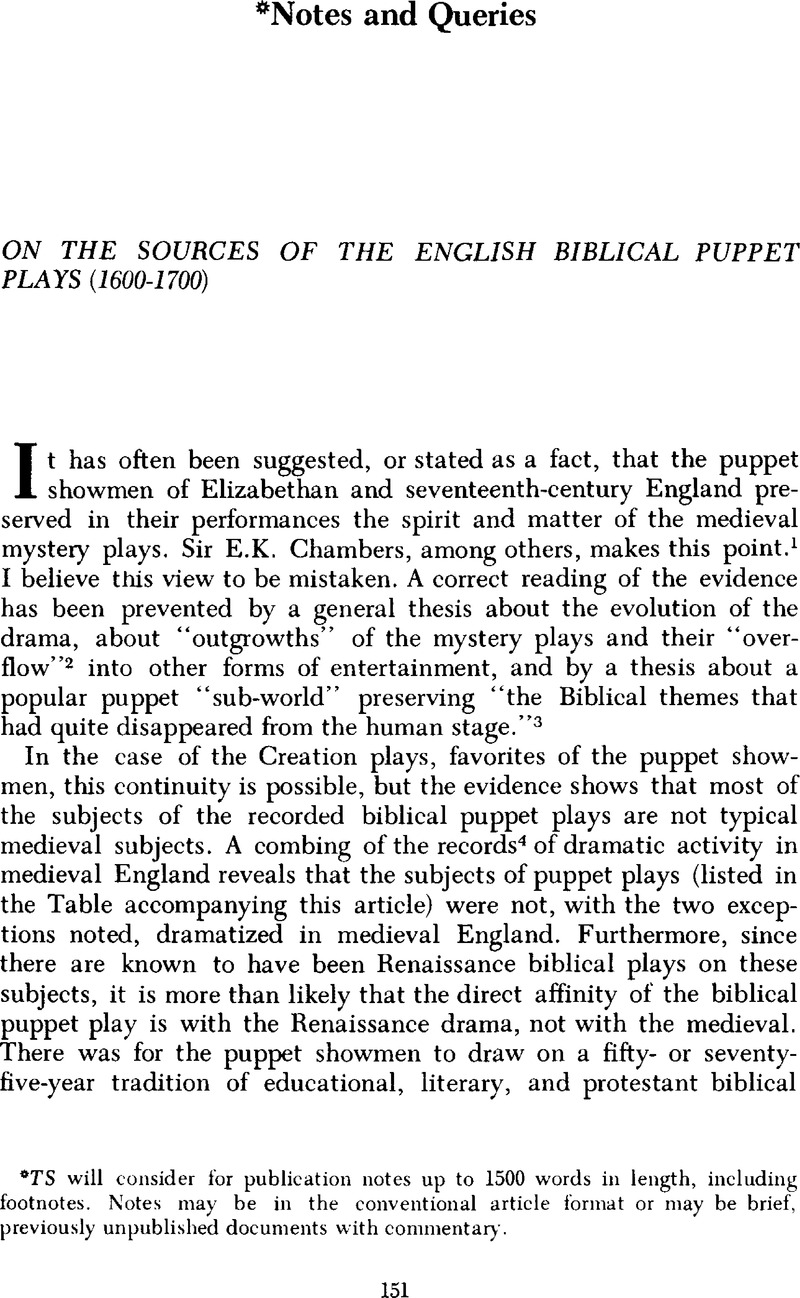No CrossRef data available.
Article contents
On the Sources of the English Biblical Puppet Plays (1600–1700)
Published online by Cambridge University Press: 07 July 2009
Abstract

- Type
- Notes and Queries
- Information
- Copyright
- Copyright © American Society for Theatre Research 1971
References
Notes
☼ TS will consider for publication notes up to 1500 words in length, including footnotes. Notes may be in the conventional article format or may be brief, previously unpublished documents with commentary.
1. Chambers, E.K., The Mediaeval Stage (Oxford 1903), II, 157, 159. The statement that the “repertory of Lanthorn Leatherhead [in Bartholomew Fair] contained a large proportion of ‘motions’ on subjects borrowed from the miracleplay” (p. 159) is not borne out by the factsGoogle Scholar.
2. Chambers, II, 149, 157.
3. Speaight, G., The History of the English Puppet Theatre (London, 1955), pp. 63–64Google Scholar; Speaight, G., Punch & Judy A History (London, 1970), pp. 33–34Google Scholar.
4. Mainly printed in Chambers, Appendix W, and in the works listed by Craig, Hardin, English Religious Drama (Oxford, 1955), p. 144Google Scholar.
5. Campbell, L.B., Divine Poetry and Drama in Sixteenth-Century England (Cambridge, 1959), pp. 192–260Google Scholar.
6. Speaight, , History of the English Puppet Theatre, p. 64Google Scholar.
7. Ed. W.W. Greg (Malone Society, 1932). The play was revived by Henslowe in 1592, first published in 1594, published for the fourth or fifth time in 1617, and performed again early in the seventeenth century. This play is about Jonah and the City of Nineveh, and by 1617 the puppet Nineveh-Jonah plays had been mentioned nine times. P. Simpson briefly suggest a connection between A Looking Glasse and the puppet plays, but he assumes the “motion” is a burlesque (Ben Jonson [Oxford, 1940], IX, 420)Google Scholar.
8. Roston, M., Biblical Drama in England (London, 1968), pp. 49 ffGoogle Scholar.
9. Dates from Campbell; Harbage, A., Annals of English Drama, rev. S. Schoenbaum (London, 1964); and ChambersGoogle Scholar.
10. Dates of entry in the Stationers Register of ballads on subjects listed in column 1. Dates from Rollins, H.E., An Analytical Index to the Ballad-Entries (1557–1709) in the Registers of the Company of Stationers of London (Chapel Hill, 1924)Google Scholar.
11. Dates from Speaight, History of the English Puppet Theatre, pp. 325–327.
12. Date of licensing, from Harbage, p. 206.


